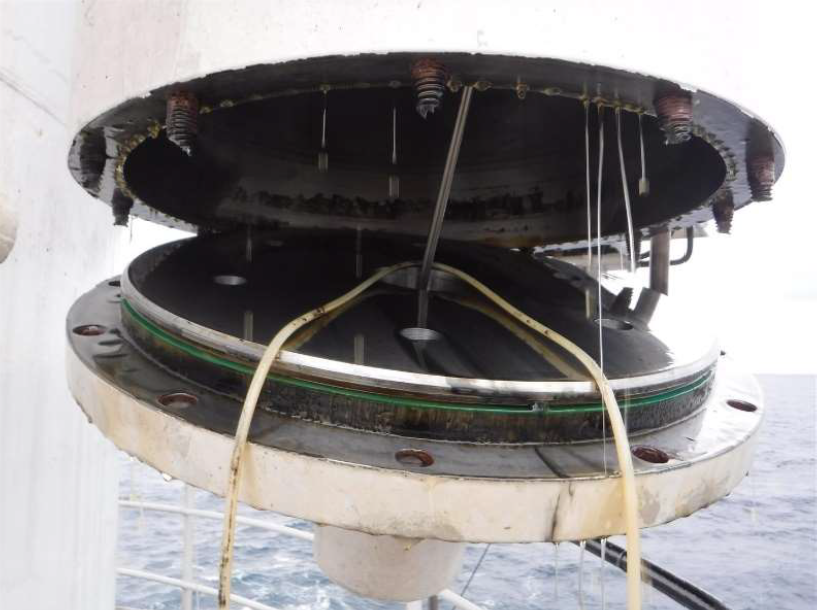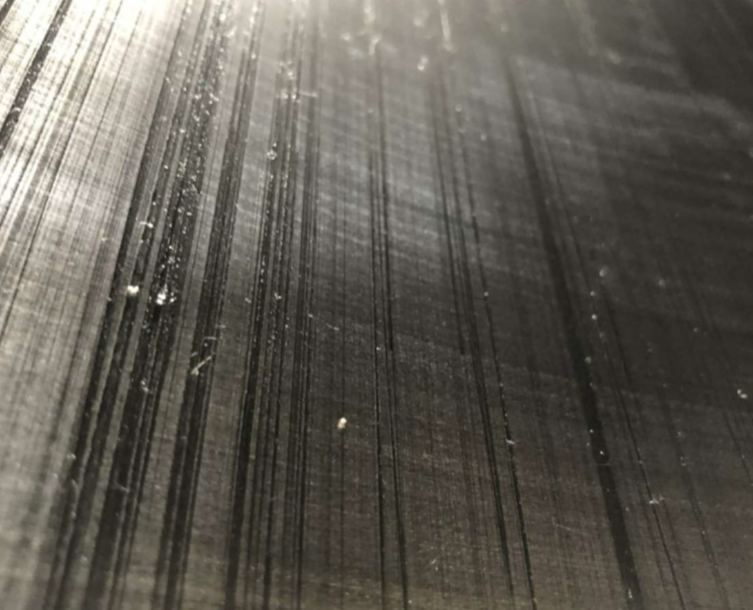Failure of AHC cylinder causing oil leak to deck
What happened
A hydraulic cylinder on an Automatic Heave Compensated crane failed. The incident occurred when an offshore vessel was engaged in the installation of a jumper line in 690m of water. The vessel was stood off at a safe distance from a drill centre; the crane was stationary at the time and waiting in AHC mode. A bang from the crane was heard from inside the crane cab and the crane automatically switched to normal mode (AHC off). A leak was spotted from the cranes right hand side. As soon as it was observed that there was an oil leak from the bottom of the AHC cylinder the crane was stopped, and the alarm raised to contain the oil.
The client’s jumper was lost as unrecoverable. Our member noted that had the incident occurred exactly over the drill centre, major damage could have been caused to subsea assets.


What went right
- The leak was spotted promptly, and the alarm raised;
- No oil was spilled to sea, all of it (approx. 150 litres) was contained on board;
- Engineers were able to remove the remaining bolts from the bottom plate on the AHC cylinder, create a temporary seal and secure the plate with new bolts, which enabled the crane to be recovered to deck.
What went wrong
Our members’ investigation noted the following:
- Poor design of AHC cylinder – Lack of pressure sensor on vacuum side drain line;
- Lack of maintenance – there was no planned overhaul of the cylinder in the manufacturer’s manual or specification;
- Lessons had not been learned from a similar incident the year before involving a high pressure HP seal on a cylinder on a sister vessel;
- The root cause of the AHC failure on the low-pressure side of the accumulator was contamination of the hydraulic system, either from the system itself or from particles that had entered the system when it was first connected.
What was the cause
During normal active heave operation, the piston travels up and down inside the cylinder and this movement controls the movement of the hook wire in relation to the vessel’s roll. This ensures that subsea, the hook remains in the same place as the vessel is rolling.
The low pressure seals became worn. This allowed oil to leak past the piston into the vacuum side. At the time of the incident the seal had failed so badly that the leak oil choked the drain lines and oil built up in the vacuum space behind the piston. The vessel then rolled; the piston began to travel compensating the hook wire. As the piston moved down the cylinder, it hit the wall of built-up oil, this transferred the force through the incompressible oil onto the small surface area of the cylinder end cover, shearing the bolts and blowing the oil out onto deck. The cylinder is not designed to take any pressure on this side of the piston.
Why did this happen
Investigators believe that at some point, contaminated oil has passed through the cylinder causing damage to the seal and scoring the cylinder. The source of this contamination could have been during an overhaul of other components and has entered the oil and found its way to the active heave cylinder. It was not known at what point in the cylinder’s lifetime this damage was sustained because the cylinder had never been inspected inside. In its lifetime the piston and seals have travelled many thousands of kilometres inside the cylinder as the active heave will move every time the ship is rolling during crane use.
The actions proposed were:
- Crane manufacturer to incorporate pressure sensor with alarm in crane computer to highlight a leaking seal before unplanned breakdown occurs;
- Crane manufacturer to review manuals and incorporate new maintenance for an inspection of the low pressure seal, check of return filters and overhaul time for the AHC cylinder.
Our member notes that a failure of the low pressure side of this equipment had never been seen before by the crane manufacturer.
Members may wish to refer to the following incidents, both of which were as a result of the failure of worn-out seals.
Safety Event
Published: 13 November 2023
Download: IMCA SF 26/23
IMCA Safety Flashes
Submit a Report
IMCA Safety Flashes summarise key safety matters and incidents, allowing lessons to be more easily learnt for the benefit of all. The effectiveness of the IMCA Safety Flash system depends on Members sharing information and so avoiding repeat incidents. Please consider adding [email protected] to your internal distribution list for safety alerts or manually submitting information on incidents you consider may be relevant. All information is anonymised or sanitised, as appropriate.
IMCA’s store terms and conditions (https://www.imca-int.com/legal-notices/terms/) apply to all downloads from IMCA’s website, including this document.
IMCA makes every effort to ensure the accuracy and reliability of the data contained in the documents it publishes, but IMCA shall not be liable for any guidance and/or recommendation and/or statement herein contained. The information contained in this document does not fulfil or replace any individual’s or Member's legal, regulatory or other duties or obligations in respect of their operations. Individuals and Members remain solely responsible for the safe, lawful and proper conduct of their operations.
